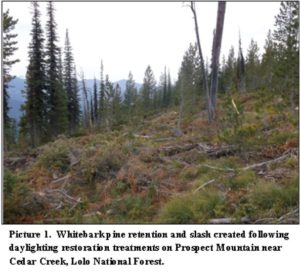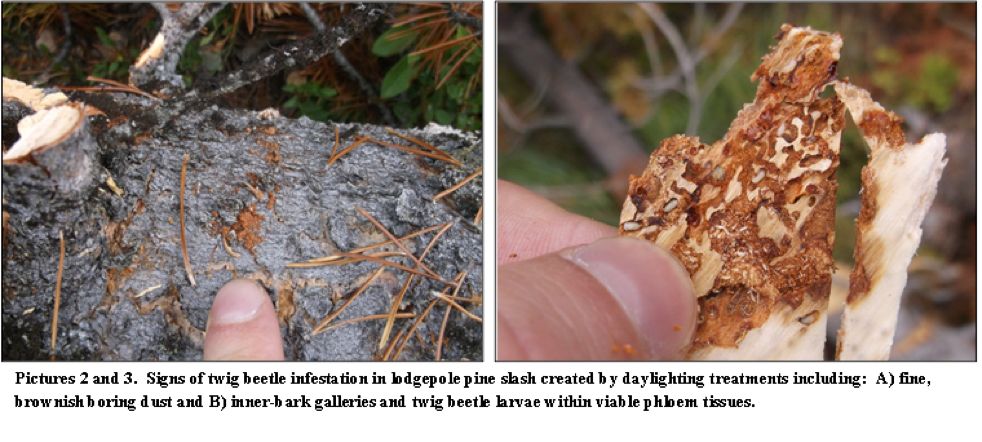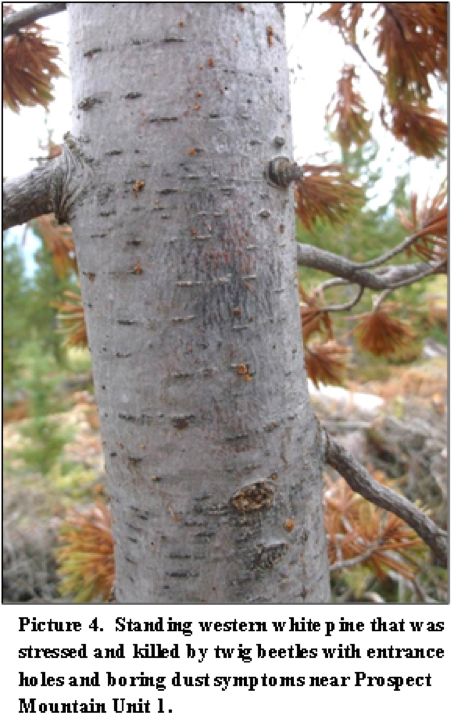2013 Prospect Mountain WBP Daylighting Phase 1
Project: Prospect Mountain Whitebark Pine Daylighting Phase I: Daylighting Whitebark Pine
Agency/Forest or Park/District: Prospect Mountain, Superior Ranger District, Lolo National Forest, Montana
Project coordinator: Bruce Erickson
Contact: Bruce Erickson, Superior Ranger District, Lolo National Forest, PO Box 460
Superior, MT 59872 406-822-3957 berickson@fs.fed.us
Cooperators
Robert Keane, Rocky Mountain Research Station
Source of funding /amount
FHP: $12,000
Supplemental funding: $3,000 from other appropriated funding
Dates of restoration efforts
August 2013
Objectives
Implement daylighting, thinning, and prescribed burning treatments to enhance regeneration and survival of whitebark pine trees and modify and reduce fuel loading and arrangement.
Acres/ha treated
30 acres
The treatment area is divided into four treatments:
- Daylight 19 acres of healthy whitebark pine saplings and young trees by clearing competing conifers from within 15 feet of each tree. Intent is to increase vigor by reducing competition and reduce mountain pine beetle hazard by altering the microclimate of the bole so trees have an improved likelihood of surviving to maturity and successfully contributing to regeneration of whitebark pine in the future.
- Daylight and underburn 11 acres of healthy whitebark pine saplings and young trees by clearing competing conifers from within 15 feet of each tree and underburning to reduce fuel accumulations. Intent is to increase vigor by reducing competition, reduce mountain pine beetle hazard by altering the microclimate of the bole, and reduce wildfire hazard by reducing fuel loads so trees have an improved likelihood of surviving to maturity and successfully contributing to regeneration of whitebark pine in the future.
- Underburn 12 acres of healthy whitebark pine saplings and young trees by hand with an emphasis on torching competing conifers and reducing surface fuels. Intent is to increase vigor, reduce mountain pine beetle hazard, and reduce wildfire hazard while creating suitable seed caching spots to encourage natural regeneration.
- Control area of 10 acres where no treatments occur.
RMRS has already installed permanent monitoring plots and they have taken individual tree measurements. They plan to measure treatment effects directly post-treatment and every five years after treatment.
Planting? If so, source of seedlings? Resistance? No
Outcome
The 30 acres of daylighting were accomplished. Because of unexpected workload imposed by the West Mullan fire, work was not accomplished by a designated crew in the timeframe planned. The work was done sporadically over the summer as crew members were available. This resulted in some issues with achieving consistent daylight spacing around the whitebark pine trees. Some areas had to be reworked by cutting more trees to meet the prescribed 15- foot daylighting radius around whitebark pine trees.
Monitoring since completion of the project
Plans for future Monitoring? Monitoring is described in the Study Plan “RESTORING WHITEBARK PINE ECOSYSTEMS: Effects of daylighting, thinning, and prescribed burning treatments (The DAYLITE study)” USDA Forest Service Fire Fuels Smoke Program RWU-4405. The study plan is available upon request from Bob Keane or Bruce Erickson.
Project monitoring last fall identified high twig beetle populations in the slash with some individual whitebark pine trees infested. We will be monitoring twig beetle activity in 2014.
Will outcome meet goals?
Yes
Future actions/follow up?
The underburn portions of the study are planned for implementation in the fall of 2015.


